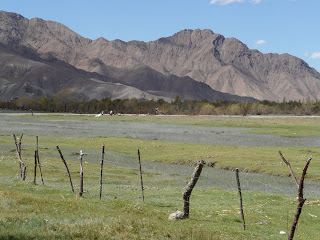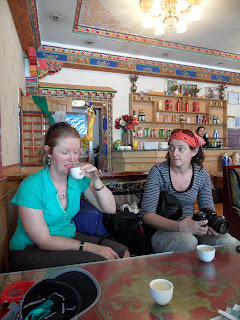Upon arriving at Lhasa airport, we were shocked at the Chinese presence in everything... signs, food, police and army. We drove along the river and through a tunnel to get to the next valley, stopping at a religious site to throw our white Tibetan scarves on a rock wall beside a carving of Buddha. The views over the nearby lake and mountains were gorgeous.
Lhasa is such a contrast from Kathmandu. The streets are wide and clean, there are footpaths to walk on and there are no groups of people hanging around the streets. It appears that there is more employment here than in Kathmandu. However, the honking of car / truck / rickshaw horns is the same!
Lhasa's altitude is 3700m and is surrounded by amazing mountains.
We had a few days in Lhasa acclimatising, enjoying the food - a mix of Tibetan and Chinese (I had Yak stew for dinner one night - yum!), and checking out all the pilgrims doing their clockwise tour of the religious sites.
Many of the pilgrims prostrate themselves all day in front of the Jokhang. This is the most sacred monastery for the Tibetans. The pilgrims lining up to get in were so devoted, they walk along with their thermos of yak butter to pour into the candles that are all around the monastery. The place has beautiful paintings and decorations and stunning views of the Potala Palace from the roof. Our guide said some of the pilgrims do this prostrating action (almost like a burpee) for up to three months!

We visited the incredible Potala Palace, built by the 5th Dalai Lama (the current one is number 14, but he's not allowed to be mentioned when in Tibet... we weren't even supposed to bring in our Lonely Planet Guidebooks because they mention him! Also, the poor Tibetans don't know who is listening and may dob them in for mentioning what China has done to Tibet. The Chinese call it 'liberation', but I think it's more like Genocide - they killed 1.2 million Tibetans and destroyed over 600 monasteries).
 |
Liberation Square (opposite Potala Palace).
It's like a mini Tiananmen Square. |
Potala Palace is incredible, towering over the city. There was so much gold inside and beautifully painted artwork on the walls. Thankfully the Chinese saw the tourist value of the Palace so didn't destroy it!
The views from the top of the Potala Palace are pretty special too.
We also visited the Sera Monastery, which has approx 200 monks at it. We saw monk debating, where they sit around in groups and are yelling questions to each other and getting quite worked up. It wasquite a sight! Then at 4pm they all suddenly stopped, sat down and started chanting. It was mesmerising.
A few of us visited the Braille Without Borders blind school, which was really interesting. I took along a few old canes from work to give out. They were very appreciative. The staff at the school are inspirational and have done a great job. The lady that spoke to us was one of the first students there and the future for people with vision impairment in Tibet is slowly improving. There were 51 gorgeous kids at the school aged 6 - 12. They all have to board there and their facilities are pretty poor to say the least.
They teach kids activities of daily living, braille, Tibetan, Chinese, English, computers and maths. They have also done a terrific job of dispelling the myths in the community that people who are blind are not capable of anything. Some of the stories they told were atrocious. Many of the students were locked in a room before they were 'found' and taken to the school, as it is considered to be bad luck for a family to have a child who is blind and they don't teach them anything or have any expectations of them at all. It's tragic! The kids at the school were gorgeous and, although poor, were enjoying life like any other children.
I felt so uplifted by the wonderful people working there and how they are changing the lives of these children. After the age of 12, they go to be integrated in the regular schools and this is turning out to be a positive experience for everyone.
A couple of the girls and I went to have a massage at the 'blind massage centre'. It was great!
 |
| Playground at the Braille Without Borders School. |
 |
| Kids playing in one of the classrooms. |













































